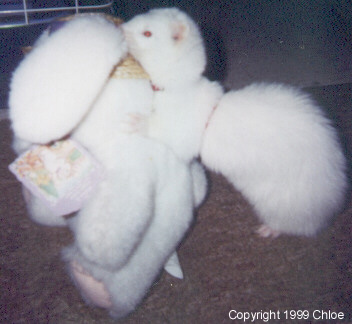
The ferret is the domesticated form of the European polecat, Mustela putorius. Mustela is Latin for weasel; putorius is from the Latin verb putor, to smell bad. This relates to the fact that polecats have scent glands from which they release a foul-smelling liquid as part of their defense mechanism.
The ferret is an animal disguised in mystery, although it has been kept in captivity for centuries. Endless stories have been told about ferrets as hunters and killers. There was a time when thousands of people kept ferrets for rabbit hunting. A ferret was placed into a rabbit hole to chase the rabbits into the nets of hunters. Ferreting had a strong following in Wales, Scotland and northern England. Then came myxomatosis, the dreaded rabbit disease. It virtually wiped out the entire rabbit population. Ferreting never recovered from that event.

My ferret Chloe, attacking her stuffed bunny.
The ferret reached the New World via South America. Ferrets were taken on board sailing ships to keep down the rat and mice populations.
Hounds were the animal of the wealthy in the chase of deer, boar and other game. The ferret became the poor man's hound. It was easily housed and could be used on common land. Along with lurcher dogs, the ferret was kept by poachers, who ventured onto the estates of the rich to secure a few rabbits. Thus, the ferret became strongly associated with working people.
The ferret's reputation is rather unsavory. It is credited with being savage, smelly, bad-tempered and untrustworthy. Nothing could be further from the truth. A ferret can be docile, friendly and entertaining if handled correctly from an early age.
Ferrets are enjoying a resurgence in popularity today. Many are found as pets in homes. As the ferret shrugs off its old negative image, it is seen in its true light.